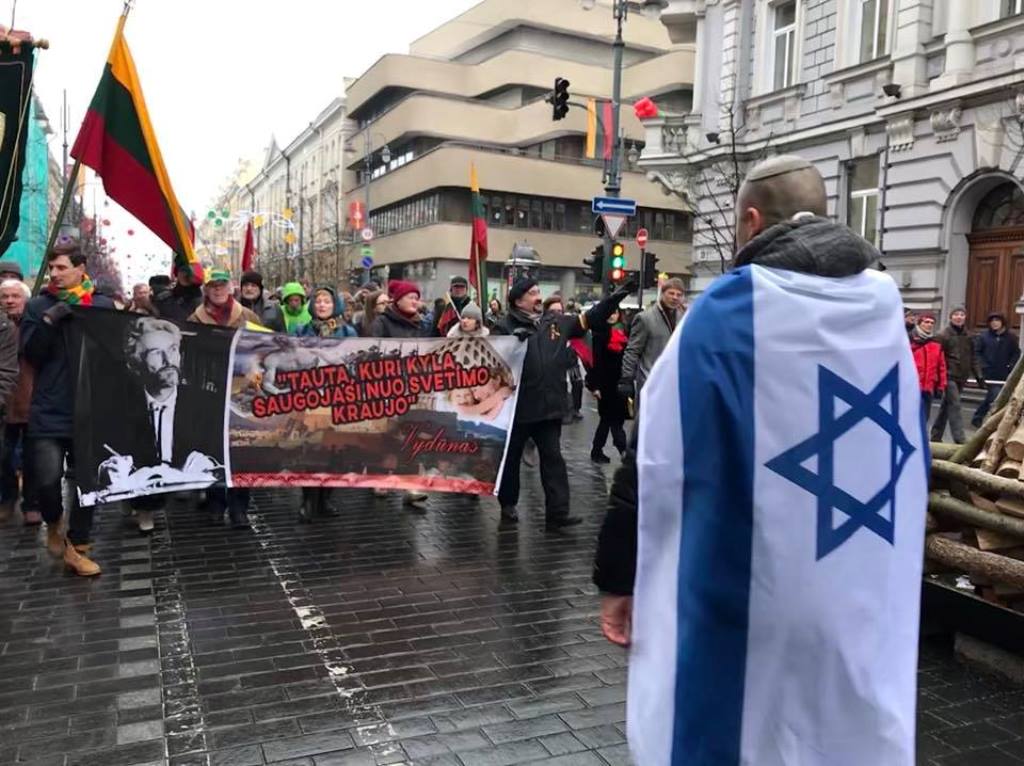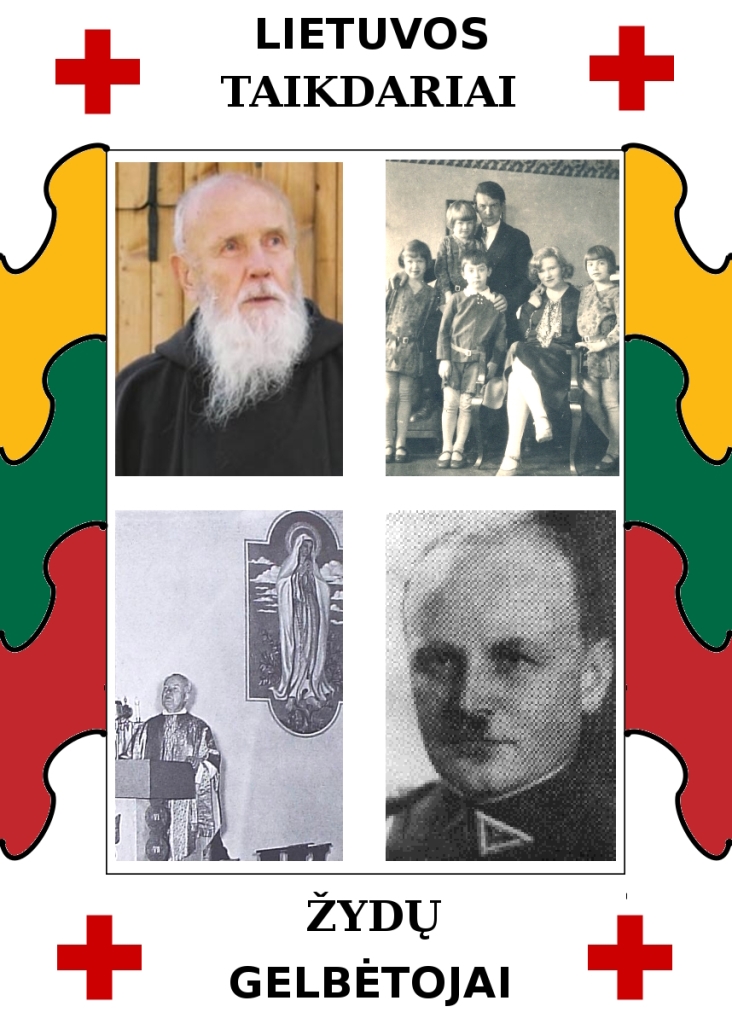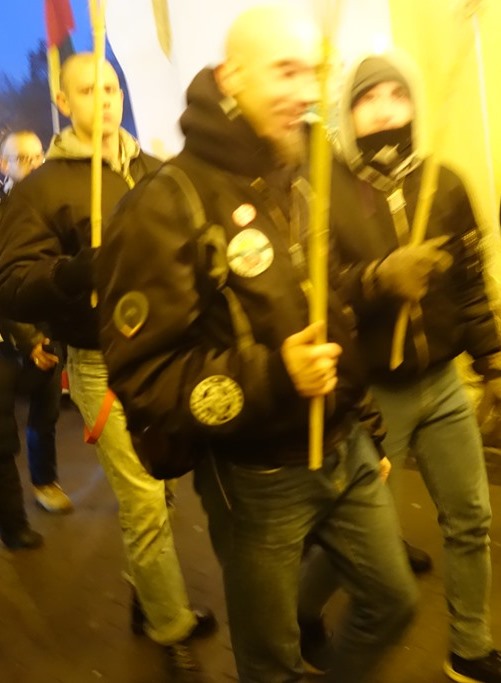VILNIUS MARCHES | KAUNAS MARCHES | REGIONAL PRO-NAZI MARCHES | COLLABORATORS GLORIFIED | ANTISEMITISM | EVENTS | OPINION
◊
Eyewitness Report by Defending History Staff with photos by Julius Norwilla. His photo gallery available here.

Lead banner reads: “WE KNOW WHO OUR NATION’S HEROES ARE. This year’s “sanitized” event in central Vilnius featured a lead banner glorifying six Nazi collaborators, five of them deeply implicated in the Lithuanian Holocaust. The torchlit march, the day’s final event, made its way from Vilnius’s most sacred Catholic shrine down through the Old City, culminating at a street named for one of the collaborators who had advocated “only” ethnic cleansing of the country’s Jewish minority in 1941.
For more on the six figures depicted on the lead banner, follow the links for (from left): Adolfas Ramanauskas-Vanagas, Jonas Noreika, Povilas Plechavičius, Kazys Škirpa, Antanas Baltūsis-Žvejas, and Juozas Ambrazevičius-Brazaitis.
It started off as a sanitized version of neo-Nazi culture made to look like just “mainstream nationalist.” But by the time the event reached its peak, it featured hundreds of people carrying torches through some of the oldest streets of Vilnius Old Town, while worshiping a banner featuring six alleged Nazi collaborators, five of them deeply implicated in the Holocaust per se, thereby symbolically expressing some kind of glee at the successful ethnic cleansing which these “heroes” supported. The Catholic Church gave the events a de facto blessing. The two open voices of morally clear protest were of the Jewish activist Daniel Lupshitz and the Catholic professor Dr. Andrius Kulikauskas. Defending History’s Julius Norwilla and Dovid Katz monitored the event.
VILNIUS—For the past decade, the Defending History team has been monitoring pro-Nazi marches in Baltic city centers, particularly those in Lithuania on national independence days, generally in central Kaunas on the 16th of February (marking Lithuania’s 1918 declaration of independence) and in central Vilnius on 11 March (marking the 1990 declaration of independence). We have consistently made clear the journal’s unstinting admiration for Lithuania and loyalty to its sacrosanct needs for security, freedom and independence in perpetuity. Just yesterday, we published our tribute on the occasion of the centenary of the 1918 rise of modern democratic Lithuania, and its inspiring recreation nearly three decades ago, in honor of which we have also launched a modest virtual mini-museum of Yiddish-Lithuanian harmony in the interwar republic.
Incidentally, we respect the same freedom of speech for ultranationalists that we have demanded for those who speak up for democratic values, and for those who dissent from state-sponsored Holocaust revisionism. We have documented, with zero support from the lavishly funded local “human rights institutions” (that seem to exist more to do PR and lavish conferences that cover up human rights issues) a series of legal and professional steps taken to silence voices of dissent or otherwise abuse human rights.
On the subject of the neo-Nazi marches, Defending History‘s objection has been to the allocation of city centers to neo-Nazis and antisemites, on the nation’s cherished independence days, which sends a horrific message of glee on the part of a tiny but influential elite, at the effects of the Holocaust here on its virtual ground zero (at the same time as the Foreign Ministry and others throw vast sums at “Jewish and Yiddish” studies in a sublime exhibition of an unfortunate state policy).
◊
So what happened this year? This year was supposed to be different. After the embarrassments of previous years, principally due to some occasional foreign press coverage of Defending History’s eyewitness reports, there was supposed to be a crackdown to ensure that the “nationalist patriotic” marches would not include such racist slogans as “Lietuva Lietuviams” (“Lithuania for Lithuanians”), and would not include the swastikas and other fascist symbols of previous years. Moreover, the February 16th event would be moved to Vilnius where there would be more control than under the aegis of some ultranationalist city leaders in Kaunas, a city whose public university continues to flaunt a shrine to a major Nazi collaborator in addition to an array of streets named for collaborators.
As ever the officially organized morning and midday events in central Vilnius were splendid, inclusive and wholesome, drawing thousands in a show of harmony and respect. But what happened at the 3 PM afternoon slot, which has traditionally been the neo-Nazis’s time for taking over the city’s main boulevard and marching right up to its parliament?
Shortly after 3 PM, the hundreds assembled at Cathedral Square began their march upward on Gedimino Boulevard. But there were no offensive chants and no offensive symbols in view. There was a strong military component of very friendly and professional personnel who went out of their way to greet our small team. One came up to the DH folks and said: “See, it has been fixed. This year it’s all normal people!” We said more or less the same to some television and radio interviews who spoke to us before the later stages of the event unfolded.
There were, to be sure, some of the offensive cast of characters from previous years, including Ričardas Čekutis, a former longtime bigwig at the state-sponsored “Genocide Research Center” that continues to bring Lithuania undeserved embarrassment (most recently for its championing of a wartime figure it said only wanted “ethnic cleansing” of the Jews, not actual genocide). But in comparison to previous years, some of which included sieg heils and “Juden raus,” this year’s event showed major progress in the sense of the state bothering to understand that it bears responsibility for what is presented on its main boulevard on the afternoon of its independence day in its cherished capital city.
Throughout this first march, from Cathedral Square up Gedimino Boulevard, there was one explicitly Jewish protester, the well known and flamboyant, and sometimes controversial (but never boring) Daniel Lupshitz, who was wrapped in a huge táles (Jewish prayer shawl) and engaged in friendly conversation with any who approached him. Among the police and security presence, many know him via his role as an informal advisor to the current mayor of Vilnius. He silently but resolutely confronted one of the most disturbing banners of this first, much milder Gedimino phase of the event, a quote by Lithuanian-Prussian author Vilius Storostas-Vydūnas (1868-1953) that translates: “The nation that rises up protects itself from alien blood.” (Yes, this was the “good part” of the nationalists’ march….). An elderly Lithuanian woman came up sand said to us: “You know, that Jewish fellow standing up to them does make a strong impression.”

Daniel Lupshitz, advisor to the mayor of Vilnius, emphasizing that he was there in a private capacity, garbed in a huge traditional Jewish prayer shawl (táles) faced down a large crowd bearing a banner with a racist slogan tying national success to the rejection of “alien blood”…
◊
Phase 1 of the march concluded at Lukiškės Square (just short of the parliament buildings), now slated to house a shrine to postwar resistance fighters. Some of the most famous are alleged Holocaust collaborators and perpetrators, and indeed, the content of the rally held at the square was to read lists of names of Forest Brothers and honor them via posters and a large screen, including some with known Nazi pasts. A big chunk of the time was dedicated to the gentleman for whom the parliament recently named 2018 in a drama that came to engulf the Israeli ambassador (and was responded to, in a way, by Defending History‘s own 2018 Person of the Year).
But as things were winding down, instructions were given for Chapter Two, calling on participants to reassemble near the famed Gates of Dawn, the city’s best-known Catholic site, at 5:45 PM. Because of Sabbath observance, Mr. Lupshitz was unable to come for that.
◊
As the after-dark part of the event was coming into focus around 6 PM at the Gates of Dawn, there were hundreds of mostly younger nationalists with torches, in the tradition of many far-right nationalist events internationally. That was when the most dramatic moment of the day came, a moment that might go down in history for its illustration of the power of one human being to redeem so very much by standing up to a fuming crowd that brims with Aryanist racial hate. One human bring who represents the humanistic and legitimate school of Lithuanian nationalism, a native of California who decades ago decided to come settle in the land of his forebears.
Just prior to the official program starting, Dr. Andrius Kulikauskas, a Lithuanian Catholic philosopher and historian who teaches at Vilnius Gediminas Technical University (VGTU), and is a long-time writer at DefendingHistory.com, got up dramatically and gave a short speech in Lithuanian to the assembled crowd on the far side of the Gates of Dawn, in which he made the following points: We love Lithuania dearly, we must acknowledge errors of the past, and we must honor the Lithuanian patriots who rescued Jewish people during the Holocaust. With this, he held up his home-made poster, featuring Lithuanian heroes who rescued Jewish neighbors, including this year’s Defending History Person of the Year, Malvina Šokelytė Valeikienė.

Philosopher and historian Dr. Andrius Kulikausks, himself a Lithuanian nationalist and Catholic thinker, stood up to the entire crowd of torch-bearing participants in the march and resolutely told them that historic mistakes were made, and that one should be honoring the Lithuanian patriots who rescued Jews during the Holocaust. He carried a self-made poster featuring just such rescuers on both its sides.
It is hard to convey the courage this took, amid near-silent hisses among the crowd that had been warned against responding visibly to any “provocations.” But at least one callout of Trockis! (Trotsky!) shattered the ultra-tense silence. Here are the two sides of Dr. Kulikauskas’s poster (text translates as “Lithuania’s Preservers of Peace, Rescuers of Jews”):
◊
The official ceremonies got underway. There seemed to be two components. One was a very Catholic texture, led by the priest Žydrūnas Vabuolas, speaking at the city’s holiest Catholic venue, known internationally for centuries at Ostra Brama (today’s Aušros Vartų — ‘The Gates of Dawn’). While he did not say anything offensive toward other groups, it constituted an official Church blessing for the entire group leading this new torchlit after-dark phase, all organized by the Nationalist Union, led by the person who chaired the event. That person, Sakalas Gorodeckis, is indeed chairman of Lithuanian Nationalists and Republicans Union (Lietuvių tautininkų ir respublikonų sąjunga).
In his own remarks he alluded to purity of the nation more than once, and announced that the torch lit march would make its way slowly down the hill on Aušros Vartų and to the end of Didžioji (Broad Street), and that the event would end at that point (before the street narrows into Pilies or Castle Street). Marchers were advised to walk very slowly given the limited route.
It was at that moment, when the torch lit hundreds began to march downward, that the event took its turn toward the rather more extreme “Kaunas model” that literally idolizes Holocaust collaborators. The huge banner from previous years in Kaunas, entitled (here in translation) WE KNOW WHO OUR NATION’S HEROES ARE was unfurled to be carried at the front of the torch lit procession. All six men on the banner are alleged Nazi collaborators, though one was killed as a traitor by the Nazis toward the end of the war. The other five are unambiguous Holocaust collaborators and supporters, each in his own way.
From the left: Adolfas Ramanauskas-Vanagas, Jonas Noreika, Povilas Plechavičius, Kazys Škirpa, Antanas Baltūsis-Žvejas, and Juozas Ambrazevičius-Brazaitis, Follow the links for more about each of these heroes.

Last year in Kaunas, this year in Vilnius: an independence day march fronted by a banner honoring six Nazi collaborators, five of whom are deeply implicated in the Lithuanian Holocaust. What is the message being sent on the 100th birthday of the modern Lithuanian democratic state?
And so, right after being blessed by a leader of the Catholic church, the crowd, in the torch lit tradition of neo-Nazis marches, marched down to the designated point featuring the banner of the six Nazi collaborators.
And then the plan changed. At the precise point where Broad Street becomes Castle Street, there was a pause of several moments as police, who kept excellent order throughout the day, made some hurried phone calls to Higher Powers, and it was announced that the march would go all the way down the hill and end at the start of Škirpa Street (Škirpos alėja), making very clearly the point of heaping more glory on one of the gentleman on the banner, a major proponent of ethnic cleansing of the nation’s Jews, whose current street name in Vilnius has brought the city much unneeded disgrace.
More Lietuva Lietuvams shirts were evident as were White Power scarves and other neo-Nazi junk.
The shouts of “Lietuva” were deafening but only at one point, did the marchers with their torches break discipline and drift into Lietuva Lietuviams (“Lithuania for Lithuanians”) for about 20 seconds before being cut off by march leaders determined to adhere to their agreement with authorities.
The event concluded at the start of Škirpa Street, near the foot of Gediminas Hill. The keynote speaker was from Estonia He spoke in English and repeatedly called for “a thousand years of ethnic purity” for Lithuania, Latvia and Estonia, and concluded with two Lithuanian words shouted at the top of his lungs: Lietuva Lietuviams!
And everyone went home as the concluding central Vilnius event marking the hundredth anniversary of independence wound down.
◊
◊
◊
Please support defending history! If not you, then who?


